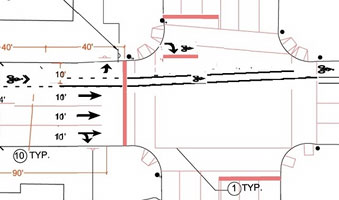DDOT tweaks L Street bike lane plan
DDOT is still on track to build the L Street cycle track this summer. At a public meeting last week, officials presented the results of their recent study and explained the L Street plans, including a few small changes they have made based on public feedback.
The lane uses a “mixing zone” to handle drivers turning left and cyclists traveling straight. About 140 feet before an intersection, the separator between the bike lane and the other lanes will turn into a dotted line. Drivers will merge (after signaling and carefully looking for cyclists) into the shared lane.
Some worried that the drivers would then take up the entire shared lane space and make it hard for cyclists continuing straight to get by. To address this, DDOT created a 4-foot wide bike space at the right edge of the mixing zone, which they will paint green with bike symbols. This should make clear to drivers that they should stay to the left and let cyclists pass to the right.
Also, DDOT has modified the plan to include flexible posts between the left turn lane and the other lanes. This means that drivers will have to merge back where the mixing zone starts, instead of waiting until the end.
At the meeting, several cyclists said they are still nervous about the mixing zone concept. They worried that drivers won’t take enough care when merging to the left. Many cyclists like the cycle tracks because they create a feeling of greater security; WABA Executive Director Shane Farthing expressed concern that the mixing zones would eliminate that comfort factor.
However, DDOT’s Mike Goodno explained that they can’t replicate the layout on 15th, where the leftmost car lane is a left turn lane with a special left turn arrow. That would leave L Street with only 1 through lane outside rush hour. Also, the study of the existing lanes showed weaknesses in that arrangement on 15th. Many cyclists still go through the intersection when left-turning cars have a green arrow, and the setup on 15th makes both cyclists and turning drivers wait much longer, said Jamie Parks from Kittleson, the consultants behind the study.
A few participants asked if DDOT could continue the green paint through the intersection. Goodno noted that an an intersection, the many vehicles driving across would quickly wear away the paint. This will be DC’s first foray into green paint on bike lanes.
The 15th and Pennsylvania lanes required cyclists, drivers and pedestrians all to adjust to slightly different behavior. People, even the occasional DC Councilmember, complained, but these lanes have all settled into a working pattern. With L Street and the mixing zones, there will be some more adjustment, and after some time passes, we will be able to judge whether the mixing zones work well, or not.
Other elements of the bike lane plan
At intersections that allow right turns, bike boxes will let cyclists cross from the bike lane in front of waiting cars to the right side of the road. On our post, commenter egk suggested instead placing the bike boxes on the cross streets, so that a cyclist moves left and then waits in front of the drivers on that cross street:
Goodno said that he thought that was a good idea and investigated it. However, a bike box in that location blocks the curb ramps, and DDOT can’t move them without far more extensive construction work.
DDOT will also be adding a more traditional bike lane on L between Pennsylvania Avenue and the start of the cycle track at 22nd Street.
Drivers will not experience much more congestion. At the most, some segments decline by 1 letter grade in “level of service,” such as from B to C. The double left turn on 18th Street at rush hour will have to become just a single left turn lane.
When the lane goes in, DPW will step up enforcement on L Street to ensure that the rightmost lane stays clear for through traffic during rush hours. Drivers of cars and trucks will be able to park there off-peak, but today that lane often gets blocked even during the peak by trucks making deliveries.


